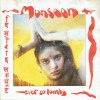Description
Additional information about this, Monsoon vinyl art.
Monsoon – The Artist
Monsoon was an early 1980s UK world/pop trio that consisted of singer Sheila Chandra, record producer Steve Coe, and bass guitarist Martin Smith. Their song “Ever So Lonely” was a popular hit that was released in various mixes and sampled in other songs. Due to differences with their label, Phonogram, Monsoon dissolved in 1982. Sheila Chandra started a solo career, Steve Coe continued writing and producing her albums, as well as Martin Smith, but often under the name Ganges Orchestra. Phonogram “posthumously” released Third Eye in 1983.
Ever So Lonley – The Song
“Ever So Lonley” is a song written by Steve Coe and originally recorded by Monsoon with Sheila Chandra on vocals. The single became a hit in the United Kingdom following a re-release in March 1982, staying on the UK Singles Chart for nine weeks. It was also a hit in Ireland, the Netherlands, and Australia but was never released as a single in the United States. Chandra was aged only 16 and had just left school when her first single was a hit. The band were later signed to Phonogram after being discovered by David Claridge and the song was the first release on his new label “The Mobile Suit Corporation”. Several different remixes were made including three by Monsoon, two by Ben Chapman, and several by Jakatta. The song has also been sampled by various artists including; The Art of Trance on the track “Monsoon” (2000) from the album Voice On Earth and by Dario G on the track “Be My Friend” (1999) on the album Sunmachine.
The Taj Mahal – The Shape
This record has been modelled into a silhouette of the Taj Mahal. The Taj Mahal (‘Crown of the Palace) is an ivory-white marble mausoleum on the right bank of the river Yamuna in the Indian city of Agra. It was commissioned in 1632 by the Mughal emperor Shah Jahan (r. 1628–1658) to house the tomb of his favourite wife, Mumtaz Mahal; it also houses the tomb of Shah Jahan himself. The tomb is the centrepiece of a 17-hectare (42-acre) complex, which includes a mosque and a guest house, and is set in formal gardens bounded on three sides by a crenellated wall. The Taj Mahal was designated as a UNESCO World Heritage Site in 1983 for being “the jewel of Muslim art in India and one of the universally admired masterpieces of the world’s heritage”. It is regarded by many as the best example of Mughal architecture and a symbol of India’s rich history. The Taj Mahal attracts more than 6 million visitors a year and in 2007, it was declared a winner of the New 7 Wonders of the World (2000–2007) initiative.
Need Help? Contact Us














Reviews
There are no reviews yet.